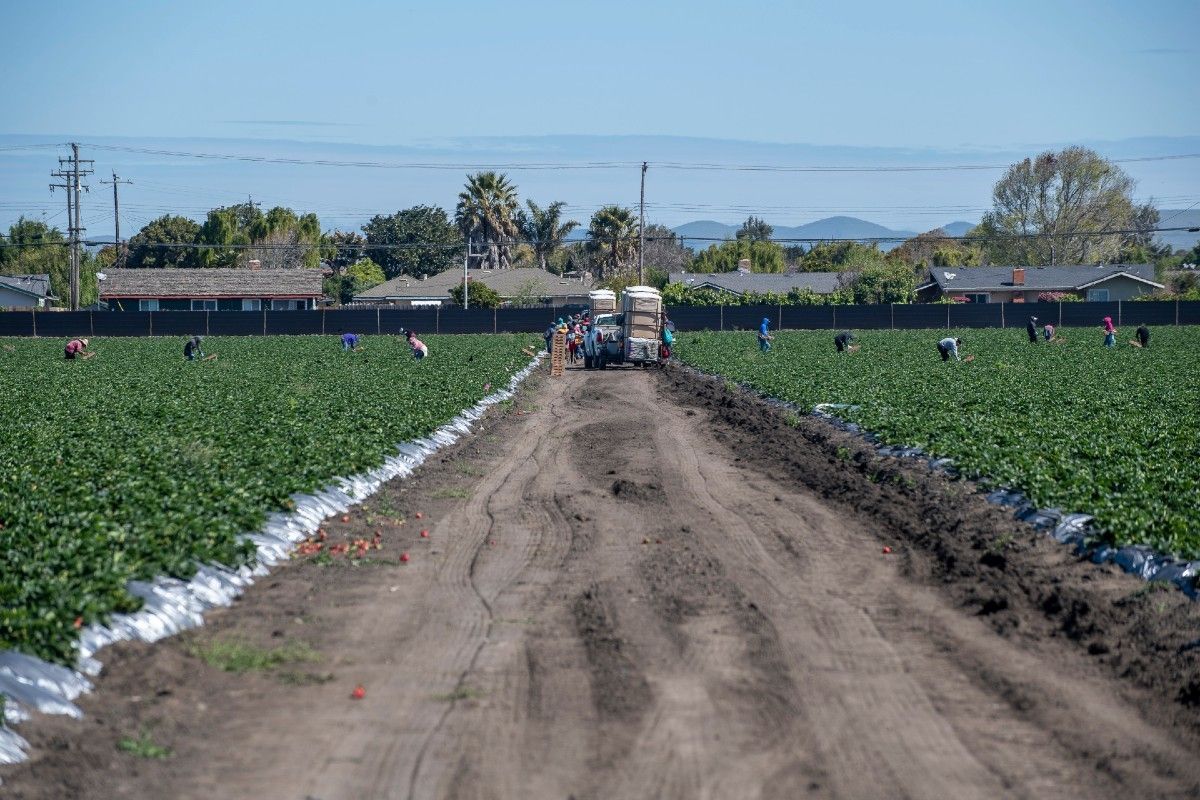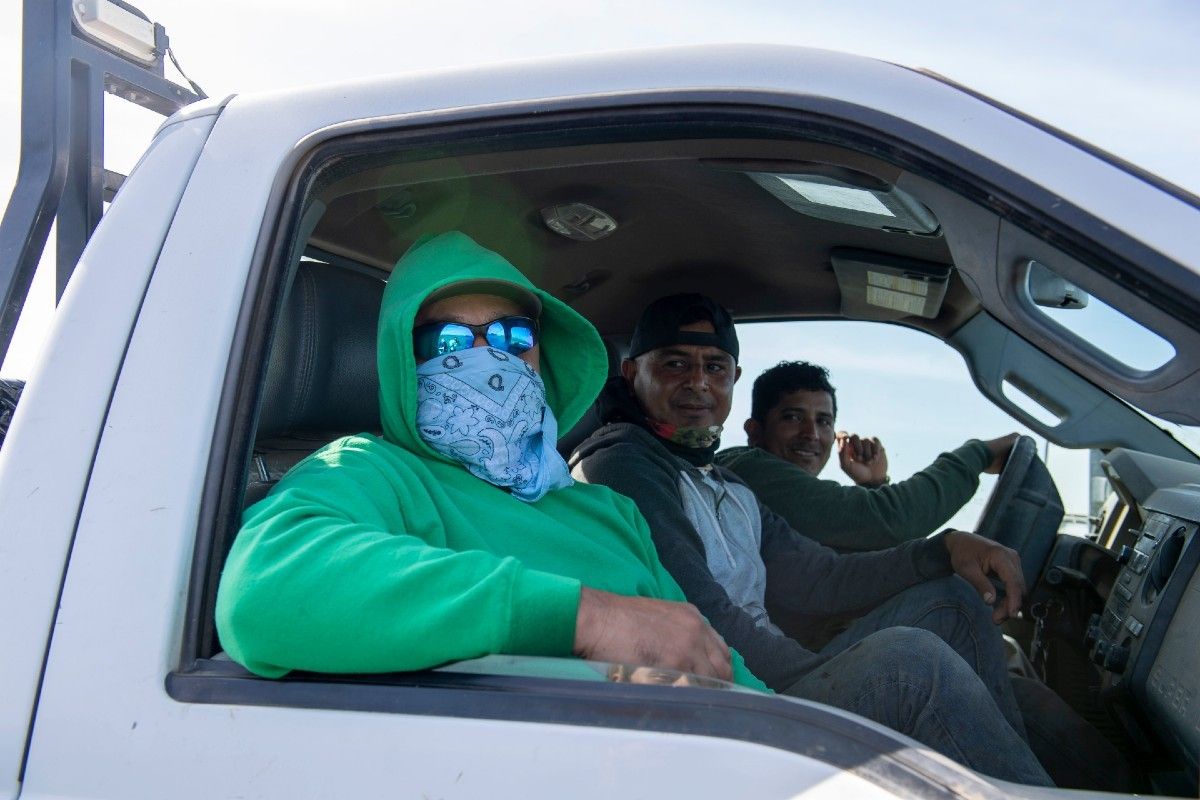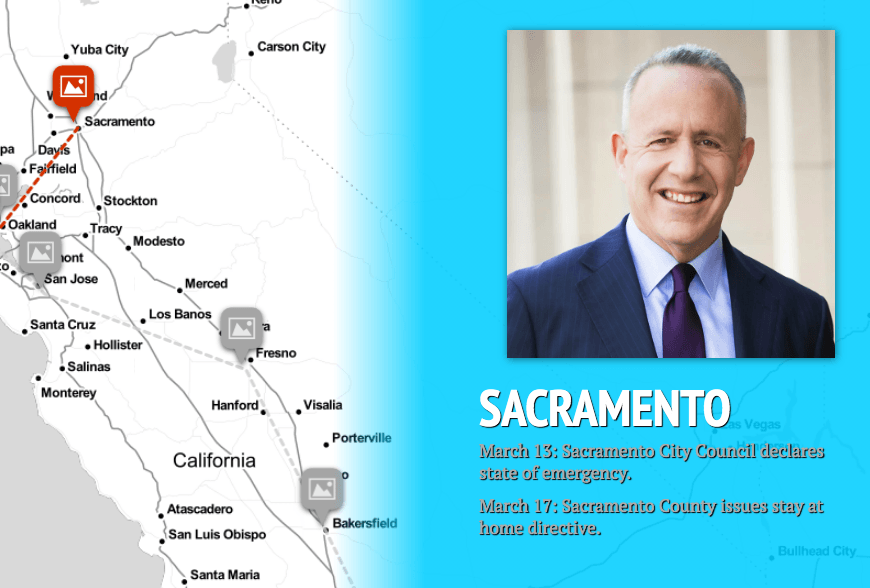
- Written by: Kacey Sycamore
Los Cien Sonoma County hosted a virtual Coronavirus Town Hall on Friday with Congressmen Mike Thompson and Jared Huffman, who outlined the economic and health challenges facing the region, and federal programs to address them.
hosted a virtual Coronavirus Town Hall on Friday with Congressmen Mike Thompson and Jared Huffman, who outlined the economic and health challenges facing the region, and federal programs to address them.
More than 300 people were registered to attend the Latino leadership organization’s first online-only, interactive conversation, hosted on Zoom and streamed on Facebook Live.
Thompson, who represents California’s 5th Congressional District, and Huffman, who represents the 2nd District, shared details of the legislation passed by Congress to address the fallout of the COVID-19 pandemic — namely the CARES Act and the Families First Act.
You can watch the full conversation, moderated by Santa Rosa attorney Oscar Pardo, below:
- Written by: Kacey Sycamore
By Kate Cimini, The Salinas Californian
 The Trump administration is considering cutting the pay of guest visa farmworkers during the coronavirus pandemic to help the farm industry. But California growers aren’t thrilled: They say it won’t help them much with their financial crisis. And they worry that it might even hurt them by creating uncertainty for their essential employees, prompting them to look elsewhere for work once the pandemic ends.
The Trump administration is considering cutting the pay of guest visa farmworkers during the coronavirus pandemic to help the farm industry. But California growers aren’t thrilled: They say it won’t help them much with their financial crisis. And they worry that it might even hurt them by creating uncertainty for their essential employees, prompting them to look elsewhere for work once the pandemic ends.
Unions and other worker advocates also worry that reducing farmworkers’ wages would cause hardships for people already living on the edge of poverty, and may end up lowering the pay of domestic farmworkers, too.
Hugo Marcos has an H-2A visa, which allows growers to temporarily employ guest workers from other countries when there is a shortage of U.S. workers willing to take the jobs. He spends his days cutting hearts of romaine lettuce for Foothill Packing, Inc., and returns around 6 p.m. to the motel where he will stay for months.
Marcos just arrived in Salinas, but this is his fourth year working U.S. fields on an H-2A visa. He has earned enough to build a two-bedroom home in the Mexican state of Michoacan, and take care of his wife and two children.
(Image: Norcal harvesting fieldworkers pick strawberries early morning on March 31, 2020. Photo by David Rodriguez, The Salinas Californian)
“Trabajar de campo es complicado y especializado,” he said. In English: “farmwork is complicated and specialized.”
It took Marcos a long time to learn the skills he has: cutting the lettuce in a perfectly flat swipe to maintain a uniform look and size, then removing excess leaves and handing the heart off to be packaged right there in the field.
More than 257,000 people worked in the U.S. on an H-2A visa in 2017. These workers have been deemed essential during the coronavirus pandemic by county, state and federal government regulations.
In California, H-2A workers earn $14.77 an hour this year, or about $118.16 for an eight-hour day, one of the highest in the country for these workers. The average wage of an H-2A farmworker, known as the “adverse effect wage rate,” or AEWR, is based on a survey of growers and farm labor contractors, and the AEWR varies state to state.
For the same labor in Mexico, Marcos said, he would earn 70 pesos an hour, something like $23.28 a day. A drop in pay would reduce his children’s quality of life, he said. “Reduciría en nivel de vida que les damos,” he said.
Yet the Trump administration’s Department of Agriculture is exploring cutting H-2A worker pay, according to an NPR report. NPR found that “new White House Chief of Staff Mark Meadows is working with Agriculture Secretary Sonny Perdue to see how to reduce wage rates for foreign guest workers on American farms.”
The USDA declined comment on whether it is considering such a change, or how it would be accomplished. The administration could announce a temporary rule change, order a new rulemaking or issue an executive order.
“During these difficult times, President Trump and Secretary Perdue are doing everything to ensure farmers have the tools to carry out the vital work of feeding the American people,” a USDA spokesman told The Californian.
By cutting worker pay, the administration hopes to keep farmers afloat through the pandemic.
Without the wage cut, researchers expect to see up to a $688.7 million decline in sales, leading to a payroll decline of up to $103.3 million between March and May of 2020.
The pandemic has shut down restaurants, schools, cafes and other regular buyers of wholesale goods, leaving farmers hauling larger loads to food banks when they can afford to, and letting food rot in fields when they can’t.
As the administration contemplates cutting pay to workers on the frontlines, farmers also may be on the verge of receiving a $16 billion bailout to keep their operations going.
But agricultural industry representatives and workers’ advocates alike say the move to cut worker pay won’t solve the food-supply-chain crisis.
“To see wages being depressed would be reason for concern and evaluation,” said Chris Valadez, president of the Grower-Shipper Association of Central California, which represents more than 300 companies. “We are one of the few industries still essential, still open for business.
“Longer term, it should cause us to reevaluate the AEWR system and what goes into it, but right now, I just think it would create more uncertainty in the mind of the employees,” Valadez said.
Union officials say a pay cut for the temporary visa workers may reduce the pay of domestic workers, too, because the H-2A pay rate is considered the average pay for all farmworkers.
“To reduce their wages at any time would be of deep concern, given that many farmworkers are struggling to feed their own families,” said Gieve Kashkooli, the political and legislative director with the United Farm Workers, a union that serves domestic and foreign farm laborers. “It would be an even deeper concern to do that during this COVID crisis while the federal government has declared farmworkers essential. And it’s a total insult to them.”
Workers already underpaid, report says
According to the Economic Policy Institute (EPI), a nonpartisan think tank, H-2A workers are already underpaid compared to other workers.
“In 2019, the average wage of all nonsupervisory farmworkers was $13.99 per hour, according to USDA, while the average wage for all workers in 2019 was $26.53 per hour, meaning the farmworker wage was just 53% of the average for all workers,” read an EPI post. “And the average wage for production and nonsupervisory nonfarm workers—the most logical cohort for workers outside of agriculture to compare with farmworkers—was $23.51.
 “In other words, farmworkers earned 60%—just three-fifths—of what production and nonsupervisory workers outside of agriculture earned.”
“In other words, farmworkers earned 60%—just three-fifths—of what production and nonsupervisory workers outside of agriculture earned.”
Anne Lopez, director of the Center for Farmworker Families, called it “un-American” to consider cutting wages during a health and economic crisis.
“They’re already impoverished,” said Lopez. “They live on the edge of survival, they have no guarantees. Right now they’re going through one of the worst periods I’ve ever seen…and to make things worse for them by cutting their pay? It’s obvious our president doesn’t consider these people as human beings.
“I think a lot of it’s racist, it’s classist, it’s to keep them where they’re at so they can’t progress. That’s why I say it’s un-American.”
Casey Creamer, president of the California Citrus Mutual, which represents 2,500 family citrus growers, said that although he had not seen a proposal from either the USDA or the Trump administration to cut H-2A wages, his group does not support cutting salaries of pickers.
(Image: Farmworkers Juan Manuel Virgen, left, and Daniel Lopez Avilez, middle, wear bandanas to protect them from then coronavirus and dust while they work in the fields of Salinas. Photo by David Rodriquez/Salinas Californian)
“It’s not a political reality, it’s not supportive of our employees that we have in place. It’s just not a thing that we do,” he said.
‘Not the most significant tool’
Some industry representatives say the move to cut wages is detracting from the ultimate problem: a sudden drop in demand.
In the Ventura-Santa Barbara area, citrus growers are leaving lemons on trees, Creamer said. Unlike other produce, which can be disked straight back into the ground and used to fertilize the soil, citrus must be harvested or it will endanger next years’ crop.
“We can hold for a little bit longer and hope that restaurants open back up,” said Creamer. “Growers will have to pay to come back in and harvest to drop food back to the ground. We’re buying some time right now but it can’t go on much longer.”
Valadez said that if the administration wants to help growers, it should “put enough money in the system so employers can pay workers.”
“I know if the food service market is down, it’s down, and there’s nothing we can magically do to change that,” he said. “However, where federal stimulus is focusing on direct payments, we also need to focus on purchasing power to get that food into the hands of people that need it.
“Lowering the AEWR is a tool but I don’t think it’s the most significant tool right now,” he said.
Valadez suggested an injection of funds into purchasers still buying food, particularly ones seeing a real upswing in customers, such as food banks.
Hunger is a problem across California, and Monterey County has one of the highest rates of food insecurity in the state. A 2016 report by the Monterey County Health Department placed the percentage of food-insecure people in the county at 34%.
At the Monterey County Food Bank, which typically serves 20% of the county’s adult population and 25% of its children, the number of people standing in line at the food bank has basically doubled, said the nonprofit’s executive director, Melissa Kendrick.
Many of those who take advantage of food banks are farmworkers themselves.
A food crisis
Some industry experts say without significant intervention, the farming landscape will be forever changed.
“We’re in a different world right now,” said Valadez. “As we move forward we might see a lower demand. That is extremely impactful to the industry and to the backbone of the industry: the workers.”
“Does going back to AEWR save the day?” asked Valadez. “I don’t know. Before COVID, I probably had an interesting quip to give you, but during this crisis I think there are other things that are more in-demand in the moment. Businesses need buyers for their product.
“We have to keep the system moving. Afterwards, we can have our debates and our cuts. But we have to keep the system moving.”
Some H-2A workers said they would still participate in the program even if wages went down, as they would make far more in the U.S. program than they would doing the same work in Mexico. Still, they said, it would be a blow to their finances and their plans.
Marcos has worked cutting romaine hearts for two years for Salinas-based Taylor Farms and two for Castroville-based Ocean Mist.
As Marcos washed up for dinner at a plastic washstand in the motel parking lot, pumping the water in bursts with his foot and lathering up with industrial green handsoap, he talked about his sons, the oldest, 8 years old, named for him.
They’re getting older, he said in Spanish, and he and his wife want to add a bedroom onto their blue-and-white home in Mexico so they could have their own rooms.
If his salary were to drop, Marcos said, it would hit his family hard. They would have to put construction plans on hold, probably for years.
“Suerte, pues, gracias a dios nos da la oportunidad venir por acá y lo aprovechamos después,” said Marcos.
“It was luck. Thank God I had the opportunity to come here. I made the most of it.”
Kate Cimini is a journalist for The Salinas Californian. This article is part of The California Divide, a collaboration among newsrooms examining income inequity and economic survival in California.
- Written by: Kacey Sycamore

The Santa Rosa Police Department has begun issuing citations to businesses and individuals who are violating the county public health order to shelter-in-place.
In the last week, the department has issued 40 business written warnings, two individual written warnings and five misdemeanor citations to individuals, Police Chief Rainer Navarro said in a video release. Citations may result in fines up to $1,000 and up to six months’ jail time.
On March 31, Sonoma County Health Officer Sundari Mase extended the initial shelter-in-place order to help slow the spread of COVID-19 through at least May 3. Residents are only allowed to leave their homes for essential activities, and only essential businesses are allowed to operate in-person.
While most community members are complying with the stay-at-home order, Navarro said, some are not.
“Our approach has been to educate, but it is now necessary to issue citations,” he said.
Navarro also said the police department has enacted “even stricter” disinfection and personal protection policies for its officers. For example, officers are wearing face coverings and gloves outside of their patrol cars.
“By now, we can all see that this is a marathon, not a sprint,” he said.
- Written by: Kacey Sycamore
By Jackie Botts, Ben Christopher, Elizabeth Castillo, Ana B. Ibarra and Matt Levin, CalMatters
 Cities have been ground zero in California’s coronavirus response — with many initiating shelter-in-place orders, organizing emergency housing for homeless people and supporting health and essential workers. But even before restrictions get lifted, mayors, managers and city councils are being tested in a new way: pandemic-induced budget deficits.
Cities have been ground zero in California’s coronavirus response — with many initiating shelter-in-place orders, organizing emergency housing for homeless people and supporting health and essential workers. But even before restrictions get lifted, mayors, managers and city councils are being tested in a new way: pandemic-induced budget deficits.
Already, unemployment is projected to be higher than it was during the Great Recession. Sales and property tax revenues have cratered. And while some of a $150 billion Coronavirus Relief Fund tucked into the federal stimulus CARES Act will go directly to large cities with a population of 500,000 or more, the League of California Cities has already declared it insufficient.
Across California cities, the clamor for a federal bailout is growing. Whatever reserve they may have built up during the recovery is being wiped out and replaced by red ink. City hall leaders now face an unsavory menu of service cuts, furloughs and staff reductions. Public employee pension and health care obligations will only add to the pain.
(Image: A woman pushes a cart past the shuttered Fox Theater in downtown Oakland on March 25, 2020. Photo by Anne Wernikoff for CalMatters)
Here’s a look at California’s 10 largest cities and how they’re responding to the coronavirus fallout:
Los Angeles: Big promises in California’s biggest city
With just under a fifth of California’s confirmed cases in his city, Los Angeles Mayor Eric Garcetti has frequently acted like a governor, often steps ahead of Gov. Gavin Newsom.
Garcetti, a Democrat, halted all evictions in mid-March, weeks before California courts did the same statewide. The city has mounted 26 free testing sites, where anyone with symptoms can get tested within two days. Last week Garcetti ordered residents to cover their faces in public, a move the state has not yet taken.
When the mayor announced a philanthropic fund to send cash cards to families, particularly those with undocumented immigrant members, 56,000 immediately applied.
Despite his rising profile as “storyteller-in-chief,” Garcetti’s big plans have sometimes fallen short. He initially promised to set up 6,000 beds for homeless individuals, but it’s now more likely to be 2,000.
All these initiatives cost big money even as sales tax revenues dry up. In a recent address, Garcetti said he expected a 30% to 40% drop in the city’s hotel occupancy tax and significant decreases in sales tax revenue. Unemployment could soar to 20%.
The mayor has moved $20 million from city reserves into an emergency COVID-19 response fund, but he said the city needs help.
“There’s no question though that we’re going to have cuts,” Garcetti said. “I’m imploring our Congress, I’m imploring our president to make sure the next round (of relief) also helps bail out cities.”
San Diego: Beach town facing budget deficit
Newsom praised San Diego for taking early and bold action to house the region’s 8,000 homeless people, including procuring more than 2,000 hotel rooms as emergency isolation units. Mayor Kevin Faulconer led an effort to turn the San Diego Convention Center into a massive homeless shelter, taking in more than 800 people without stable housing.
But those extraordinary measures come with extraordinary bills for California’s second largest city. The repurposing of the convention center will cost $2.8 million per month; the hotel rooms, $6 million per month.
While federal, state and county dollars will offset some of those costs, the city’s coffers will be strained at a time when hotel tax and sales tax receipts—two key revenue streams in the tourism-centric city—are plummeting. The city faces a $250 million deficit, and Faulconer has called for cuts to libraries, recreation centers and the arts to make up the shortfall.
“Make no mistake, these are going to be some of the most significant cutbacks in San Diego history,” the Republican mayor said in late March.
San Jose: A $100 million hit to Silicon Valley
San Jose’s budget will take at least a $100 million hit because of the coronavirus pandemic, according to Mayor Sam Liccardo. And that’s still an early projection. He wouldn’t be surprised if it will be worse. “This is going to be a rough ride,” said the Democrat.
Residents have seen it before: The city endured a painful pension battle in the aftermath of the last recession, eventually losing a third of its workforce due to a hiring freeze, pay cuts and employee attrition.
Now, Silicon Valley is taking another blow as a viral hotspot. Last month, the fire department had to manage an outbreak of COVID-19 cases among its first responders. As one of the regions to be hit early, Santa Clara County was among six counties that initiated a shelter-in-place order on March 17, two days before a statewide order went into effect.
Still, the area is resilient. To help people impacted by the pandemic, the community created Silicon Valley Strong, which has raised more than $20 million to help the area’s most vulnerable residents, small businesses and nonprofits.
The current relief bill should help reimburse the city’s emergency response efforts but Liccardo hopes to see more financial help from Washington, D.C.
San Francisco: First to lockdown yet homeless remain unsheltered

San Francisco has been upheld as a model for how to deal with the pandemic but Mayor London Breed isn’t resting on her laurels. During the 1918 Spanish Flu, San Francisco introduced aggressive social distancing in the fall, tamping down the initial outbreak, only to open back up prematurely, with lethal consequences.
This year’s positive gains to date have — like all of San Francisco’s achievements — been marred by its most conspicuous failing: the city’s massive unsheltered homeless population.
So far more than 90 residents and 10 staff at San Francisco’s largest shelter have tested positive for coronavirus, the largest single cluster of cases in the city. It’s fueled criticism that the city has failed to protect its most vulnerable.
Earlier this week, San Francisco’s board of supervisors passed an ordinance demanding that Breed’s administration lease 8,250 hotel rooms, to get the estimated 8,000 people living on the street in doors by April 26. So far, the city has leased about 2,000 and sheltered nearly 800 people.
“There is no way we’re going to be able to accomplish the goals of the ordinance,” said Breed, a Democrat. Supervisors hope she rises to the challenge.
San Francisco is trying to ramp up services just as its finances are being gutted. The city’s controller recently estimated the pandemic will push the city between $1.1 and $1.7 billion into the red over the next two years — wiping out the city’s $800 million in reserves.
But those estimates are preliminary and depend on just how hard this all hits the economy — one with plenty of stay-at-home-ready tech workers, but also a disproportionate number of tourism, hospitality and restaurant workers.
“We’re in the middle of an unprecedented economic shock and we’re in the middle of a bit of data vacuum,” said Ted Egan, chief economist for the city. “There’s not a lot we do know at this point.”
Fresno: ‘Want our economy to come back’
Fresno Mayor Lee Brand first issued a shelter-in-place order for his city of more than 500,000 people on March 18, one day before the governor asked all Californians to stay at home. For the most part, the order is working, he said.
“People in Fresno get it, they’re staying at home, they want our economy to come back,” Brand said.
Prior to coronavirus, Fresno’s economy was in one of the best shapes it had been in a long time. After struggling for years to jump back from the last recession, the city’s 2020 budget boasted $34 million in reserves, the biggest in the city’s history, he said. In recent years, the city hired more police officers and boosted city services.
“We are the only city in California with a fully funded pension,” said the Republican mayor.
Last May, the city even hit a new mark: an unemployment rate under 5%. More often, Fresno’s unemployment rate is typically higher than state and national averages.
Now those gains are threatened. People are losing jobs and sales tax, a big source of city revenue, is being significantly impacted. Brand said he’d like to see cities included in another round of relief funding from the federal government.
Locally, the city set up a $750,000 fund to help small businesses. The relief program allows owners to apply for a zero-interest loan that will be forgiven after one year if their business is still operating.
Sacramento: Capital city seeks assistance

A recent influx of Bay Area transplants will help the sixth-largest city in California qualify for nearly $90 million in federal assistance from the Coronavirus Relief Fund.
Sacramento Mayor Darrell Steinberg hopes that money can buoy city coffers as California’s capital braces for a prolonged downturn. The budget for the remainder of this fiscal year, which ends June 30, should hold — but cuts loom.
“We’re going to have to figure out how to make it up,” said Steinberg spokeswoman Mary Lynne Vellinga. “We’re hoping there will be some more assistance coming down the pike.”
Sacramento will also be tested in its response to a growing population of people experiencing homelessness. Steinberg, a Democrat and co-chair of a statewide homelessness task force, has instructed staff to come up with longer-term housing strategies for people placed in temporary hotels or trailers.
Long Beach: Burning through overtime
Long Beach projects revenue losses and increased expenses brought on by the coronavirus pandemic will cost the city between $38 million and $44 million during the current fiscal year ending in September. And that’s optimistic.
City finance director John Gross noted his projections assume the city will enter a recovery period soon after May. Otherwise, he warns, the city “should be prepared for more adverse impacts.”
Long Beach is being hit by the loss of sales tax, oil revenue and a transient occupancy tax, which is paid by hotel guests. The city is also burning through staff overtime and other costs associated with its response.
The city closed down on March 19, following Los Angeles County’s “safer at home” order. So far, the majority of the city’s deaths have been linked to nursing homes and long-term care facilities.
The city has opened a free clinic at Long Beach City College, where people can be assessed and referred to testing for COVID-19. Near the clinic, the city also opened a drive-thru testing site. The centers are staffed by the city’s own Long Beach Medical Reserve Corps, a program that was in place years before the state’s recently launched Health Corps.
Oakland: Exacerbating economic and racial inequalities

On March 9, long before most mayors had to contend with the possibility of a pandemic, the Grand Princess, a ship full of contagious cruise takers, docked in the Port of Oakland.
“That’s the moment it went from being a problem in the world to a problem right here at home,” said Mayor Libby Schaaf, a Democrat.
Since then the city, like much of the Bay Area, has — so far — not seen the massive death tolls and overcrowded hospitals that were once forecast. But the pandemic has exacerbated the city’s long-standing economic and racial inequalities, said Schaaf.
Even with San Francisco across the bay, 15% of Oakland households do not have Internet access. Of the 1,100 small business owners who applied for emergency relief from a city-sponsored charity fund, seven out of 10 made less than 35% of the area’s median income.
The municipal budget has been “decimated,” Schaaf said. The city has already laid off hundreds of temporary workers.
Some of Oakland’s pre-pandemic responses to homelessness are helping. The creation of one-person shed camps and sanctioned RV parks for the homeless has reduced shelter crowding — a potential contagion cluster.
Schaaf said the city is planning to move 50 people from those group shelters into hotels. She said she hopes to convert many into permanent housing though funding is now scarce.
Bakersfield: Missed out on stimulus funding
The city of nearly 400,000 residents failed to qualify for direct federal aid under the Coronavirus Relief Fund because of the population cutoff. But Bakersfield will be able to cushion the blow thanks to a local sales tax measure passed two years ago to bolster the economy and reduce homelessness.
The tax increase has generated more than $50 million. While about half has already been allocated, money can still be tapped to help deal with the local downturn, said City Manager Christian Clegg.
“It is a saving grace,” he said. “We’ll have to be really strategic, but we’ll actually have some ability to do a few new things next year when most cities will be cutting back.”
Still, Clegg is expecting a double-digit reduction in sales tax revenue and hopes Congress will reduce the population threshold in the next round of stimulus spending.
Meanwhile, the county continues to battle the virus as the number of confirmed cases rises in Kern County. As of this week, the county reported nearly 500 COVID-19 cases with more than 300 in patients between the ages of 18 and 49.
Anaheim: An economy built on crowds
Anaheim made international headlines when Disneyland closed for the third time in history in early March, sputtering the local economy to a halt.
The pandemic has hit the city’s workforce and budget hard — both depend heavily on large groups of people bumping up against each other in the city’s theme parks, hotels and convention centers. The city believes that at least 10,000 workers in the tourism industry have lost jobs and predicts a minimum revenue loss of at least $10 million, mostly from hotel and sales tax, said city spokesman Mike Lyster.
While the city has left public health management to Orange County, it has used $1.4 million in state funds to open a third homeless shelter and has repurposed the Honda Center, usually home to the Anaheim Ducks ice hockey team, to house food bank distributions for thousands of people at a time.
Already Republican Mayor Harry Sidhu, himself the owner of several El Pollo Loco franchises, says he has a $15 million plan to restart the economy. It includes $8 million to support seniors, workers who have lost jobs and people who are struggling with rent. Nearly all of the rest would go to VisitAnaheim.org, the city’s main driver of tourism, which has laid off half of its staff. City leaders are cautiously optimistic that some restaurants could open for dine-in business again in May or June.
“The challenge for finances is getting our economy moving again as soon as it’s safe to do so,” Sidhu said. “But we know economic recovery will be gradual.”
CalMatters.org is a nonprofit, nonpartisan media venture explaining California policies and politics.
- Acts of Grace from Everyday Californians Are Getting Us Through
- Recursos Alimentarios Durante COVID-19
- COVID-19: Leaders Discuss Food Insecurity and Safety
- Sonoma County Medical Facilities Must Screen Staff, Visitors for COVID-19 Symptoms and Require Masks
- Reopen California? That’s The Toughest Phase Yet, Newsom Says
- Undocumented Workers Face Obstacles Qualifying for Benefits During the Pandemic
- COVID-19: Food Resources
- Santa Rosa Fire Department Creates Pandemic Response Unit
- Kaiser Employees Receive Help With Child Care, Shelter and Extra Leave Under Union Agreement
- Sonoma County Human Services Department Answers Questions About Public Benefits During COVID-19
- Santa Clara County Says Shelter-In-Place Appears to Be Working, Provides COVID-19 Updates
- Santa Rosa CityBus to Further Reduce Service in Response to Pandemic
- California Offers Discounted Hotel Rooms to Health Workers Exposed to Coronavirus
- Here’s How Putting California’s Homeless in Hotels Actually Works
- Sonoma County To Establish Surge Hospital At Sonoma State University
- COVID-19: Recursos Para Indocumentados y Sin Beneficios
- COVID-19: Educational Resources for Learning at Home
- Covid-19 Business Roundtable: Sonoma County Is Hurting
- COVID-19: Resources for the Undocumented and Uninsured
- California Eases Child Care Regulations for Critical Workers
- Wear a Mask! OK, But What Kind?
- Without Shelter-In-Place Order, COVID-19 Patients Would Overwhelm Sonoma County Hospitals
- Asm. Wood Asks Public to Raise Awareness About Dangers of Domestic Violence Amid COVID-19
- COVID-19: Santa Clara County Resources
- A Coronavirus Property Tax Delay? Californians Shouldn’t Count On It
- Sonoma County Will Consider Property Tax Penalty Waivers on Case-by-Case Basis
- COVID-19: How to Help
- ‘Am I Going to Die?’ Alone and Scared, Confined Seniors Struggle with Anxiety
- Sonoma Joins Six Bay Area Counties And Extends Shelter-in-Place Order
- California Starts Recruiting Retired and Student Doctors, Nurses to Handle Surge in Severely Sick People
- New Model Projects Coronavirus Deaths In California Will Peak In Late April
- Santa Rosa Police Department Mourns Loss of Detective
- What is an Equitable Response to COVID-19: Interview With Ana Lugo
- California Ramps Up Output of Ventilators As COVID-19 Cases Grow
- COVID-19: Financial Resources for Sonoma County Residents
- Santa Rosa Outlines COVID-19 Support for Homeless
- Los Angeles Will Mirror New York As Coronavirus Surges, Newsom and Garcetti Warn
- COVID-19: Sonoma County Resources for Seniors and Vulnerable Populations
- Here’s What Happens to Science When California’s Researchers Shelter in Place
- COVID-19: Sonoma County Mental Health Resources
- Sonoma County Office of Education Recommends Schools Extend On-Campus Closures
- Undocumented Workers Struggle as Economy Grinds to a Halt
- All Parks Closed in Sonoma County
- Live Virtual Town Hall - Coronavirus: What You Need to Know – Tuesday at 7pm
- Sonoma County Sup. Susan Gorin Coronavirus Update 3-23-20
- SMART Makes Additional Schedule Changes Amid Statewide Shelter-in-Place Orders
- How Overwhelmed is California’s Health Care System About to Be?
- Shelters Work to Prevent Spread of Coronavirus Among Residents
- Newsom: Coronavirus Likely To Close California Schools for Rest of the Year
- Meals on Wheels Offers Free Food Delivery to Qualifying Seniors
- More Than 22 Million Californians Could Contract Coronavirus Without Mitigation, According To Gov. Newsom
- California and Coronavirus Testing Right Now: 3/18/20
- SMART Cancels Selected Weekday Service Because of Shelter-in-Place Orders
- Sonoma County Health Officer Issues Shelter in Place Orders
- SCOE Announcement: All Sonoma County School Districts Have Announced Suspension of In-Person Classes
- Mayor Joe Callinan's Statement on Coronavirus in Rohnert Park
- Nine Active Coronavirus Cases Reported in Sonoma County
- Santa Rosa City School Classes Suspended Through April 5; Students to Complete Assignments at Home
- County Moves From Advisory to Order on Event Cancellations
- Video Discusses California Response to COVID-19
- Demonstrators Demand More Protections For Undocumented Community
- As Coronavirus Toll Rises Statewide, So Does Health Care Workers’ Alarm
- Listen Live: Special Statewide Coronavirus Special – Friday at 2pm
- Coronavirus Special & Resources
- Sonoma County Health Officer Advises Canceling Large Indoor Events
- Sonoma County Point-in-Time Count Aims to Tally The Homeless Population
- For Gig Workers and Hourly Earners Coronavirus Is a Test
- Coronavirus - Listen Live Wednesday at 7pm
- “Your Bills Don’t Get Sick”: Workers Say Coronavirus Prevention Isn’t Easy
- 30 Healthcare Workers at Local Hospital Directed to Self-Quarantine, According to Their Union
- Coronavirus: U.S. Death Toll Now At 14; New Cases In Maryland, Colorado, Pennsylvania
- California Schools Brace for a Coronavirus Disruption
- March 2020 Vote: Election Results
- County Health Officials Work to Track Down Contacts of Local Coronavirus Patient
- 2nd Sonoma County Resident Diagnosed With Novel Coronavirus After Returning From Cruise
- AB5 Sparks Controversy Among California's Independent Contractors
- The Developer Bonus Tucked Into the School Bond on Your Ballot
- Annual Pliny the Younger Beer Release Boosts Tourism in Sonoma County
- California Pushes For More Coronavirus Testing After First Case Of Community Transmission
- Proposition 13 Seeks $15 Billion for California's Schools
- New Coronavirus Affects Tourism in San Francisco's Chinatown
- David Cook Challenges Gorin For First District Seat
- Gorin Runs for a Third Term on the Sonoma County Board of Supervisors
- Former Mayor Chris Coursey Challenges Zane for District 3 Seat
- Shirlee Zane Defends Her Seat on the Sonoma County Board of Supervisors
- Lynda Hopkins Makes Her Case for a Second Term as Supervisor
- Mike Hilber Challenges Lynda Hopkins for District 5 Seat
- Interview: Reporter Will Houston Lays Out the Pros and Cons of Measure I
- Local Activist Speaks Out on Missed Opportunity in Cancelled "American Dirt" Talk
- California Lawmakers Have Refused to Restrict Flavored Vaping —Is That About to Change?
- Lisa See, Author of "The Island of Sea Women," Speaks at Sonoma Valley Regional Library
- In California, Not Every Kid Has a Fair Chance at Success
- California Students Missing School Due to Wildfires and Other Disasters
- Educators Release Plan for Expanding the Arts in Schools
- Sonoma County Plans to Clear Joe Rodota Trail By Friday
- Podcast: Activist homeless moms score an Oakland win
- Doctors Fail to Help Patients Stop Smoking, Says Report
- Rodota Trail Situation Delays Homeless Count for a Month
- Former Director of IOLERO Works to Pass Initiative to Strengthen the Office
- Sonoma County Prepares to Evict Campers Along the Joe Rodota Trail
- Sanctioned Homeless Camp at Los Guilicos Scheduled to Open Sunday
- Sonoma County Libraries Host Tamale Making Workshops
- Meet Leah Gold, Healdsburg's New Mayor for 2020
- Around 1,000 People Attend Santa Rosa Women's March
- Contractors Begin to Set Up Sanctioned Encampment Near Oakmont
- Supervisors Pick Sonoma Valley for Temporary Homeless Shelter
- Next Stop for Free College: Cal State University?
- WATCH LIVE: Managers Read Impeachment Articles, Senators Sworn In Ahead Of Trial – Thursday at 7am
- Sonoma County Women’s March to Take Place Saturday
- Cities Should Act on Homelessness or Face Lawsuits, Newsom Task Force Says
- Do You Know What Should Go in Your Emergency Kit?
- Sonoma County Library Hosts Disaster Preparedness Classes
- Should California Restrict Building in High-Risk Fire Areas?
- Santa Rosa Junior College Receives $7 Million for Disaster Recovery Workforce Training
- Anniversary Gives Rialto Cinemas Founder Chance to Reflect
- Sonoma West Publishers Plans Big Changes for 2020
- New Book Offers Background on Ukraine's People and Culture
- Author Ibram X. Kendi Says "Not Racist" is Not Enough
- Schools Can Hire Teachers of Color, but Will They Stay?
- Diversifying the Ranks of Teachers. Race and Gender Matter
- Sonoma County Releases Resident Health Report Card
- Emerald Cup Cannabis Festival Attracts Visitors From Across the Country
- Santa Rosa City Council Votes To Terminate Rental Price Gouging Ordinance
- Death of Petaluma Man Calls Use of Carotid Hold Into Question
- Santa Rosa Police Department Finishes Community Listening Sessions
- PG&E Announces $13.5 Billion Settlement With Victims Of Northern California Wildfires
- Can California Reduce Homelessness Through Better Prevention?
- Organization Works to Improve First Responder Mental Health
- Local Non-Profits Running Out of Funding for Fire Aid
- On Thanksgiving, Remembering an Anniversary
- California Burning, Episode 4: The Wildland/Urban Interface – Sunday at 10am
- Sonoma County EDB Opens Disaster Loan Outreach Center for Kincade Fire Victims
- Journalist Lowell Bergman Shares Tales of a Storied Career – Sunday at 4pm
- California Burning Podcast: The Science of Fire Behavior
- New Documentary Celebrates First LGBTQ+ Native Powwow
- Impacts Expected on Russian River After Kincade Fire
- Healdsburg Residents Undeterred by Kincade Fire
- A Year After the Camp Fire, Survivors Share Stories of Loss and Healing
- Building Resilience After Tragedy
- KBBF Radio Santa Rosa Updates Community During Kincade Fire
- 2017 Lessons Saved Lives and Property During Kincade Fire
- 'Halloween Do-Over' Brings Joy to Healdsburg After Fire
- Documentary "Men Caring" Honors Those Who Support Adults With Disabilities
- Local Assistance Center Will Open Today Through Wednesday in Healdsburg
- Code Blue Advisory Especially Concerning for Those Living Outside
- For Many Survivors, Kincade Fire Brings Back Trauma
- PG&E Expects Third Severe Wind Event 10-29 and 10-30
- The Current PG&E Power Shutoff – Emergency Information
- How to Prepare for Fires, Power Outages and Other Emergencies
- California Burning Podcast: Using Fire to Protect Forests
- Kincade Fire Update: Kincade Fire Fully Contained
- PG&E Initiates Second Public Safety Power Shut Off in October - What You Need to Know
- School Closure Announcements for the Week of Monday, November 4
- Survivors of Camp Fire and Tubbs Fire Look Back and Ahead
- Power Shut Off Prompts Modified Hours, Closures for Some Santa Rosa Schools
- Santa Rosa Middle Schoolers Talk to an Astronaut Aboard the ISS
- One Injured in Shooting Near Ridgway High School Campus; School Lockdowns Lifted
- Find Out if Your Service May Be Impacted by a Public Safety Power Shut Off event
- 26 Insurance Companies to Continue Paying Survivors' Rent
- New Documentary Addresses Gaps in Health Insurance Access
- Sonoma County Needs Your Help to Create a Power Outage Economic Impact Report
- Great Shakeout Earthquake Drills Planned for Thursday
- 100th Anniversary of Women's Suffrage Comes with Complexity
- Local Author Writes a Guidebook for Immigrant Parents
- Fire Survivors React to Power Shut-off
- Residents Observe Anniversary of the Sonoma Complex Fires
- Sonoma County Ridesharing Service Aims to Help Women Feel Safer
- Fire Survivors Demand Insurance Companies Continue to Cover Rent
- City of Santa Rosa Unveils New Emergency Warning Sirens
- Smokey the Bear Has Affected Forest Management for Decades
- Julián Castro Addresses Top Issues Facing Californians
- Behind the Scenes at one of the Nation’s Largest Cannabis Companies
- Rohnert Park Opens Emergency Cooling Centers
- Santa Rosa Will Open Cooling Centers Tuesday and Wednesday
- Group Asks Santa Rosa Businesses to Hasten $15 Minimum Wage
- PG&E Announces Planned Public Safety Power Shut Offs for This Week
- West County High School District Negotiates with Teachers
- West Sonoma County Teachers May Strike Over Salaries
- President & CEO Nancy Dobbs to Retire
- Roseland Mural Welcomed into the Community
- Trauma Threatens To Impact School Attendance In Paradise
- Paradise School Counselors Address High Rates of PTSD Among Students
- Educators Use Poetry to Help Kids Talk About Trauma
- Forum Celebrates Women Leaders at NASA Ames Research Center
- Sonoma County Leaders Discuss Sexism in Politics During Panel
- Study Shows Climate Change Could Threaten Oyster Habitat
- Director Ann Shin Examines Intelligence Industry in New Film
- Local Jewish Leader Questions Trump's 'Disloyalty' Claim
- Housing Insecurity Is Taking a Toll on Youth’s Health
- Three Years In, Legal Cannabis Still Causing Fights
- Controlled Burns Could Help Prevent California's Megafires
- Rainer Navarro Becomes New Police Chief of Santa Rosa
- Changes in Math Education Cause Anxiety Among Parents
- October 2017 Wildfires Are Affecting Crucial Health Programs
- Protesters Urge Sonoma County to Divest from Private Prisons
- Portraits of Unhoused Neighbors Emphasize Humanity
- Annual Mochilada Backpack Giveaway Kicks off the School Year
- Schulz Museum Celebrates Woodstock Festival on its 50th Anniversary
- Rep. Huffman Talks Local Issues and Trump at Point Reyes
- Local Priest Reacts to National Cathedral Statement on Trump
- Agencies Face Stricter Guidelines When Evicting the Homeless
- Santa Rosa Holds Public Hearing on PG&E Rate Hike
- Bohemian Club Provides Talent for Monte Rio Variety Show
- Bohemian Grove Annual Encampment Ends for the Summer
- Residents Celebrate Agricultural Roots at Sonoma County Fair
- Families Celebrate Sonoma County Fair Despite Increased Security
- Officials Address Safety Along SMART Train Corridor
- Supervisor Zane Cites Progress, Concerns in Kaiser Talks
- Grand Jury Commends Sonoma County Jail Mental Health Program
- Grand Jury Finds Problems Within Behavioral Health Division
- Santa Rosa Symphony Performs Free Concert
- Mendocino Winemakers Consider Plan to Boost Tourism and Sales
- Santa Rosa Priest Accused of Stealing over $95,000 from Parish
- Nine Barlow Businesses Sue Over Flood Damages
- Food for Thought to Close Forestville Store but Retain Focus
- Sonoma County Library Eliminates Overdue Fines
- Museum of Sonoma County Opens Exhibition on History of Cannabis
- Santa Rosa Residents Protest Detention of Migrant Children
- California HOPE Crisis Counseling Ends
- Local Group Shares Hotline to Protect Undocumented Immigrants
- Sonoma County Inspects Rural Properties for Fire Safety
- Host of KPCC's The Big One Podcast Shares Earthquake Tips
- 'Hairspray': The Perfect Musical for this Moment
- Roseland Residents Give Input on 2050 General Plan
- Book Tells Stories of Refugees Exiled 'Home' to Cambodia
- California on Independence Day in 1776
- Sonoma County Struggles With Property Tax Loss from 2017 Fires
- State Bill to Boost Housing Density Stalls in the Legislature
- Teenage Vaping on the Rise in Sonoma County
- Sonoma County Interfaith Council Denounces Hate
- Experts Showcase Fire Resistant Building Materials
- Stacey Abrams in Conversation with NorCal Public Media
- KRCB Wins Three Awards from the Public Radio Journalists Association
- Low-Income Students Face Food Insecurity During Summer Break
- PG&E Agrees to $415 Million Settlement for North Bay Fires
- Civilians Who Tested Agent Orange Now Sick, Dying: Podcast
- Sonoma County Board of Supervisors Finalizes Budget
- Firing Forests to Save Them: Could Native Traditions Save Lives?
- A Statewide Flex Alert Calls for Energy Conservation on Tuesday, June 11
- Petaluma Business Leaders Work to Prevent Opioid Deaths
- Report Warns 2020 Census Could Undercount Millions
- Yolo County's Sand Fire Forces Evacuations Near Guinda
- Against All Odds, Paradise Students Graduate on Home Campus
- Grist Finds Link Between Pollution and Infant Death in San Bernardino
- Santa Rosa High School Lockdown Lifted, Suspect in Custody
- Citizen Input Sought for Santa Rosa's Future
- Reveal Finds Rampant Wage Theft in the Caregiving Industry
- KRCB TV Highlights the Wine Industry’s Unsung Heroes
- Local Activists Bring Green New Deal Principles to Sonoma
- Capital Public Radio Announces Move to Downtown Sacramento
- Activist Group Sues County Over Andy Lopez Records
- Hope for Sonoma's Coast; Other Calif. Areas Under Siege
- Sonoma County Activists Address Climate Change at Town Hall
- Mormon Temple in Oakland Open to Public for Limited Time
- Israel's Consul General in S.F. Condemns Anti-Semitism
- Kaiser CEO Tyson Meets with Families on Mental Health
- Prepare for Disasters by Getting to Know Your Neighbors
- Pulitzer Prize-winning Poet: 'I Love Petaluma'
- New Health Officer Tackles Measles and Other Top Concerns
- FEMA Hosts Disaster Preparedness Symposium in Santa Rosa
- Political Cartoonist Speaks on the Importance of Satire
- Sonoma County Sheriff Releases Andy Lopez Case Files
- Alegría De La Cruz, Newest Schools Trustee, Aims at Equity
- More Coffey Park Residents Begin to Return Home
- Family Turns Grief to Activism After Daughter's Suicide
- News: Connect the Bay Follow Up -Your Housing Questions Answered
- Fishermen Cautiously Optimistic About Salmon Season Forecast
- Meet the New Director of Sonoma County's Watchdog Office
- Crab Season Ends Early to Protect Whales
- YWCA Educates Public on Domestic Abuse After Recent Tragedies
- Santa Rosa City Council Skeptical of Regional Housing Plan
- Guerneville Residents Work to Repair Their Homes, Lives
- Guerneville Businesses Work to Reopen A Month After Flood
- Barlow Tenants Question Why Flood Plan Didn’t Work
- Miss Sonoma County 2019 Breaks Down Barriers
- Garden Society Presents Pot Podcast and Products for Women
- City of Healdsburg Tables Renter Protection Ordinance
- Landslide Threatens Several Homes in Forestville
- Counties: No Criminal Charges Against PG&E in 2017 Wildfires
- Greg Sarris: Author, Professor, Chairman of Local Tribe
- Sonoma County Emergency Manager Speaks on Flood Recovery
- Sonoma County Residents Search for Flood Recovery Assistance
- Rep. Huffman Tours Barlow in Sebastopol Following Flood
- Russian River Flood Recovery Resource Page
- Santa Rosa Declares Local Emergency; No Worry Yet on Water
- Sebastopol Voters Debate Leasing Local Hospital
- New SSU Exec Commits to Diversity, First Generation Students
- Healdsburg Mayor David Hagele Defends Housing Budget
- Northern Elephant Seals Take Over Drake's Beach at Point Reyes
- Legal Marijuana Makes Talking About Safety Harder for Some Parents
- Petaluma Mayor Teresa Barrett Hopes to Tackle Housing Shortage
- Windsor Mayor Foppoli: No Use Fighting District Elections
- David Rabbitt Steps in as Chair of the Sonoma County Board of Supervisors
- California Senator Dodd Reacts to State of the State Address
- Gov. Newsom State of the State: Housing, Health, PG&E, Trump
- North Bay Celebrates Annual Pliny the Younger Release
- Scientists Release Scale Ranking Atmospheric River Intensity
- Local Agencies Address Flood Control on Russian River
- French WW II Spy Brings Story of Courage to Petaluma
- Mayor Amy Harrington Talks About Upcoming Changes for 2019
- Informe: County Sheriff Plans Better Community Relations
- Informe: Essick, Sonoma County Sheriff Plans Prison Reform
- Informe: Santa Rosa Mayor Questions Need for Translations
- Informe: Santa Rosa's Mayor on the City's Homeless Crisis
- Informe: Santa Rosa Mayor Schwedhelm Lays Out Priorities
- Informe: Tom Schwedhelm Becomes Santa Rosa Mayor
- Santa Rosa Mayor Talks About his Priorities for 2019
- Volunteers Help Sonoma County Track Homelessness
- Santa Rosa Women’s March Spurs Excitement for 2020 Elections
- PG&E Bankruptcy Imminent; Banks Offer Billions in Financing
- Political Forum Blue-Green Eggs and Ham Draws Over 400
- 'Zero Waste' on KRCB TV in the North Bay - Jan 22; We Revisit Radio Report
- Council Member Victoria Fleming Talks About Goals for 2019
- Santa Rosa Diocese Releases List of Clergy Members Accused of Abuse
- Fear of Gangs Driving Central Americans North: Podcast
- New Sonoma County Sheriff Hopes to Improve Community Relations
- Report Highlights Sonoma County Employment Trends
- Rep. Jackie Speier Suggests Border Compromise via DACA
- Snoopy's Home Ice to Celebrate 50th Anniversary in 2019
- Living with Lead: 'Like Crabs in a Barrel'
- Living Downstream Preview: Tour Uncovers Richmond Poisons
- Native Fire Practices Can Make Communities Safer
- Community Health Workers Help Gain Environmental Justice
- Woodstock and Red-Haired Girl Get Their Day in 2019
- County Agrees to $3 Million Lopez Settlement
- Emerald Cup Draws Cannabis Experts, Entrepreneurs and Fans
- Emerald Cup Prize to Willie Nelson, Others Enjoy Legal Smoke
- Sonoma Residents Work to Reduce Health Disparities
- Journalist Tess Vigeland Leads Camp Fire Reporting Effort
- Sexual Assault Prevention Educator Opposes Title IX Changes
- Coffey Strong Heads to Butte County to Share Advice
- Immigration Tied to Benefits? County Schools Head Says No
- North Bay Residents Offer Hope, Aid to Camp Fire Evacuees
- Sonoma County to Create New Emergency Management Department
- Community Members Debate How to Best Spend Homelessness Aid Grant
- Santa Rosa Official Offers Advice to Camp Fire Survivors
- Santa Rosa City Council Votes to Extend Renter Protections
- California Seeks Input on Housing Recovery Funds
- Dogs Compete in Sheep Herding at Hopland Research Center
- Santa Rosa Hosts 2018 California Economic Summit
- In Short Time, Conductor Lecce-Chong Puts Stamp on Symphony
- Music Inspires Climate Activists at Global Summit
- Climate Summit Contest: Unlikely Company Wins Funding
- Displaced Camp Fire Evacuees Consider What Comes Next
- Camp Fire Evacuees Sleep in Cars, Tents in Chico Parking Lot
- Poor Air Quality Poses Health Hazard for Workers
- Commentary: One Year On, Cannabis Legalization Mostly On Track
- KRCB's Steve Mencher and Adia White Discuss the Midterm Election
- Equity a Key Topic at 26th Annual Latino Health Forum
- Shomrei Torah Hosts Service for Tree of Life Shooting Victims
- The Difficult Birth of the Graton Resort and Casino
- Santa Rosa Voters Deliberate Affordable Housing Measure
- Sonoma County Works to Finalize Disaster Recovery Plan
- As City Builds New Park in Roseland, Whose Voices Are Heard?
- Sebastopol Building First in the Region to Use Hempcrete
- $12 Million in State Funds to Aid the Homeless in Sonoma Co.
- 'Pictures of a Gone City' Presents Bay Area, Warts and All
- Sonoma Co. Releases Results of Emergency Alert Tests
- Huffman Opponent Dale Mensing Supports Trump and DACA
- Rep. Jared Huffman Running on Accomplishments and Opposition to Trump
- One Year After the Oct. Wildfires, Many Families Are Still Uprooted
- Coffey Park Resident Shares her Experience a Year after the Fires
- More Counseling Services Needed for Spanish Speakers
- On Fire Anniversary, Recalling 'Battle to Save Jack London's Mountain'
- Cannabis Commentary: Return to Pot Prohibition Impossible
- Emergency Alert Test Lacks Spanish Translation for Broadcast
- Creative Sonoma Art Program Helps Students Cope With Trauma
- Organizations Work to Remove Language Barriers in Disasters
- Grape Stomping Ushers in the Harvest Season
- Grape Harvest Underway Across the North Bay
- Kavanaugh-Ford Testify Before Senate Judiciary – Watch Live Beginning at 7 am
- After a Month in Palestine, Empathy for Plight of Refugees
- Violence Prevention Partnership Keeps Kids out of Gangs
- Santa Rosa Hosts Gang Prevention Training for Parents
- Sonoma Co. Seeks Funds for Homelessness, Mental Health
- Sebastopol Peace Wall Adds Ellsberg, Huerta, and Two Locals
- North Bay Farm Shows Some Agriculture Can Help the Earth
- Mendocino Company Uses Goats to Reduce Wildfire Risk
- "Reflections After the Fire" Aims to Ease Trauma Through Art
- Gov. Jerry Brown Blasts Trump on Climate Change at SF Summit
- Global Climate Summit Update: Protecting Forests, People
- Meet Our New Cannabis Commentator, David Downs
- Sonoma County Tests Wireless Emergency Alerts
- Mendocino Company Markets Wild Seaweed as a Healthy Snack
- Climate Summit Takes Over San Francisco
- North Bay Residents March for Climate, Jobs and Justice
- Grand Jury Details Upgrades for Sonoma Emergency Response
- Sonoma County Civil Grand Jury Faults Emergency Response
- Spanish Speakers Question Officials at Fire Recovery Event
- Monarchs and Milkweed: Giving Butterflies a Boost
- Cannabis Expert David Downs: Market in Flux, Changes Certain
- Charles M. Schulz Museum to Host Auction for Wildfire Relief
- Expanded Life Jacket Program Saves Lives on Russian River
- Homeless Series Continues: Meet Chris and Cheri
- Firefighters Make Progress on Largest California Wildfires
- Mendocino County Farm Saved from Ranch Fire by Quick Action
- Sonoma County Provides Resources for Businesses Recovering from October Wildfires
- Wildfire Season Prompts Another Look at Emergency Warnings in California
- Cannabis Growers and Sellers in Sonoma County Confront Angry Neighbors
- Federated Indians of Graton Rancheria Donate $280,000; Fully Fund Rohnert Park Food Needs

 Live Radio
Live Radio



